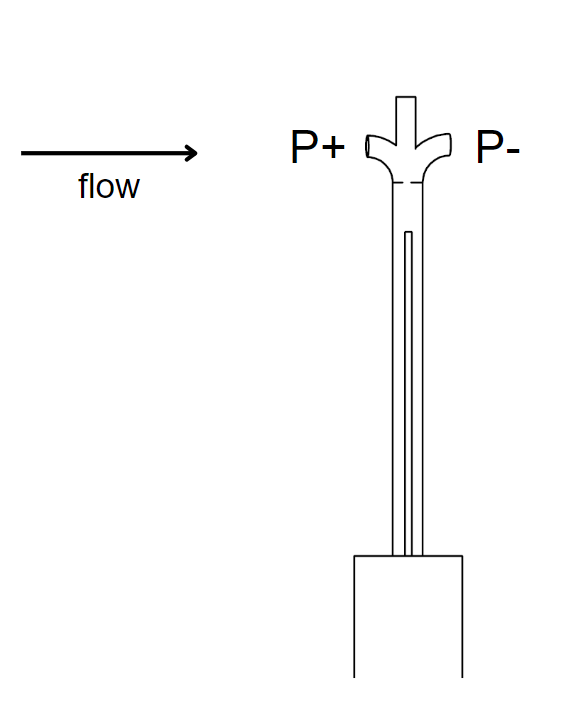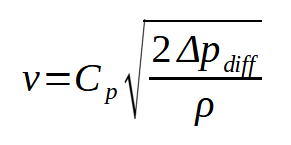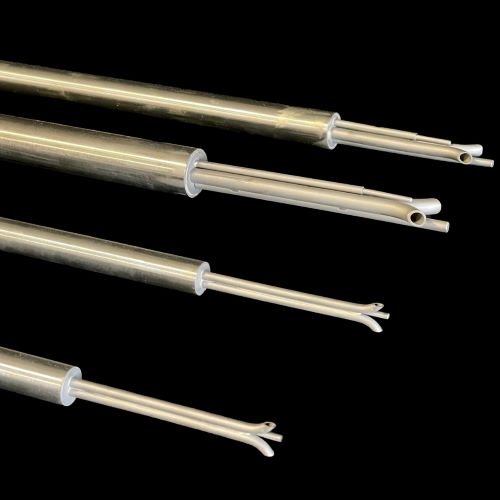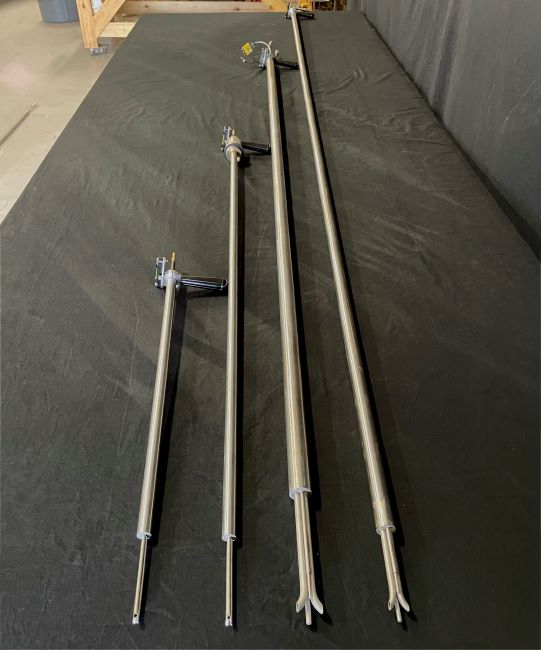This is part one of a blog series where we answer all of your probing questions… about probes! Airflow Sciences Equipment designs and manufactures probes and data acquisition systems that are used throughout the industrial sector. Wondering if an S-type velocity probe is right for you? Read on!
How does an S-type probe work?

An S-type (Stausscheibe) pitot probe measures velocity in a gas stream by employing Bernoulli’s principle. An S-type probe features two pressure orifices, each connected to a pressure transducer or manometer. When encountering a flow stream, the impact orifice that is against the flow (P+) measures the pressure from the fluid pushing toward it (the total pressure). The wake orifice (P-) faces away from the flow and measures the local pressure, in the wake of the probe. The difference between these two pressure values Δp is an indication of the velocity of the fluid, where a greater difference in pressure corresponds to a higher velocity. With an S-type probe, the velocity v is calculated from the pressure difference by solving the Bernoulli equation:

The constant Cp is the calibration coefficient for the probe assembly. For a standard S-type probe geometry, a typical value of Cp is 0.84.
When used to determine the volumetric flow rate, probe measurements are typically made across the duct or stack diameter, at multiple traverse points. The velocities at each of these points are then averaged to determine the mean velocity of the flow stream. To accurately calculate the volumetric flow rate, the fluid density ρ must also be determined. Our S-type probes are equipped with thermocouples to aid in these calculations.
What is the measurement range?
ASE’s S-probes can be calibrated over a measurement range of 10 ft/s – 200 ft/s (3 m/s – 60 m/s) and are rated up to temperatures of 950°F (510°C).

What advantages and disadvantages should I consider?
An S-type or reverse pitot-static probe is a compact and affordable option for gas flow measurement. Compared to a standard (L-shaped) pitot probe, it is less prone to pluggage from debris in the gas stream. S-type probes can be highly accurate when used in the right kinds of flow conditions.
The accuracy of an S-type pitot probe diminishes when the flow is not axial. As a result, accurate measurements with an S-type probe cannot be made close to bends, elbows, or large disturbances in the duct. S-type probes are not recommended to measure flow velocity in non-axial or swirling flow streams. For non-axial flow, we instead recommend a 3D probe (prism, spherical or non-nulling).
S-type probes are also sensitive to misalignment either in the yaw angle or pitch angle. If misalignment occurs in either the pitch or yaw position, the resulting flow rate will be biased which could cause companies to over-estimate or under-estimate their emissions. To avoid inaccuracies in situations with non-axial flow, a 2D or 3D probe such as a prism or spherical probe can be used.
How can I customize the S-type pitot probe?

Airflow Sciences Equipment offers S-type probes in a range of sizes, with accessory options to fit your needs. Each probe can be customized to the length you need, with available sizes of up to 20 feet. A Type K thermocouple can also be integrated into most S-probes and umbilicals.
Umbilicals are heavy duty for industrial use, yet lightweight for portability, with your choice of connection types for pressure lines. Standard lengths are 25 ft, but longer umbilicals are available to accommodate your facility needs.
Companies may opt to add a leak-check kit to any S-probe, along with a bubble level indicator to aid in proper alignment of the probe. For smaller pipe diameters, a traverse rod is available: a color-coded guide to allow for easy marking of multiple traverse locations.
What data acquisition system should I use with this probe?
S-probes have two pressure lines and an optional thermocouple line that can be connected to various readout devices. One basic option is a handheld digital manometer and handheld thermocouple reader. With these devices, a user will record the measured pressures and temperatures and then calculate velocity of the flow stream.
Alternatively, the probe can be connected to a Bluetooth meter that reads both pressure and temperature in a singledevice. This meter is programmable, logs data, takes time averages, and communicates with laptops via Bluetooth. With the resulting data logs, velocity calculations can be less time-consuming.
You can also pair an S-type probe with one of our more advanced data acquisition systems to make flow testing even easier, such as our 3DDAS or Magic Box. Our data acquisition systems perform automated data collection and the calculations needed to determine velocity, simplifying your test protocol and reducing human error. Both of these systems provide the resources you need to comply with Method 2 testing protocols.
S-type probes are used for a wide variety of industrial testing, including fan flow testing according to ASME PTC 11 or AMCA 803, and stack RATA testing according to EPA Methods 2 and 2G.
S-type probes require regular calibration in a wind tunnel built to the standards of EPA Method 2 and outfitted with NIST-traceable measurement hardware. ASE S-probes are calibrated after fabrication in our highly accurate, onsite wind tunnel. Annual re-certification is recommended.
About Airflow Sciences Equipment
We are flow testing engineers, test technicians, and systems experts who started to develop our own equipment as a test services provider. As industry-trusted test engineers, we wanted highly accurate, automated systems that were easier to use in tough industrial settings. Today, we offer an impressive line-up of test equipment used across many industry sectors and proudly manufactured in the USA.
Airflow Sciences Equipment is a sister company to Airflow Sciences Corporation, where we continue to provide flow testing services, engineering consultation, and numerical flow modeling. We have the utmost confidence in our test equipment because it’s the same equipment we use ourselves.
For more info and/or quotes on any equipment or services, contact us today.
